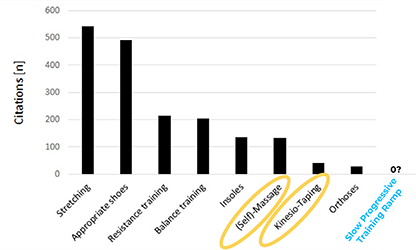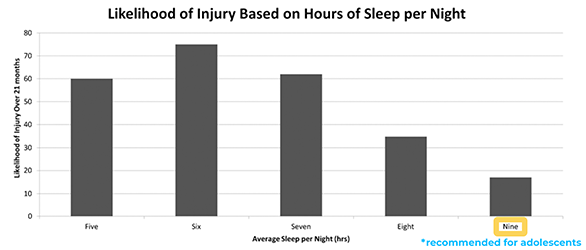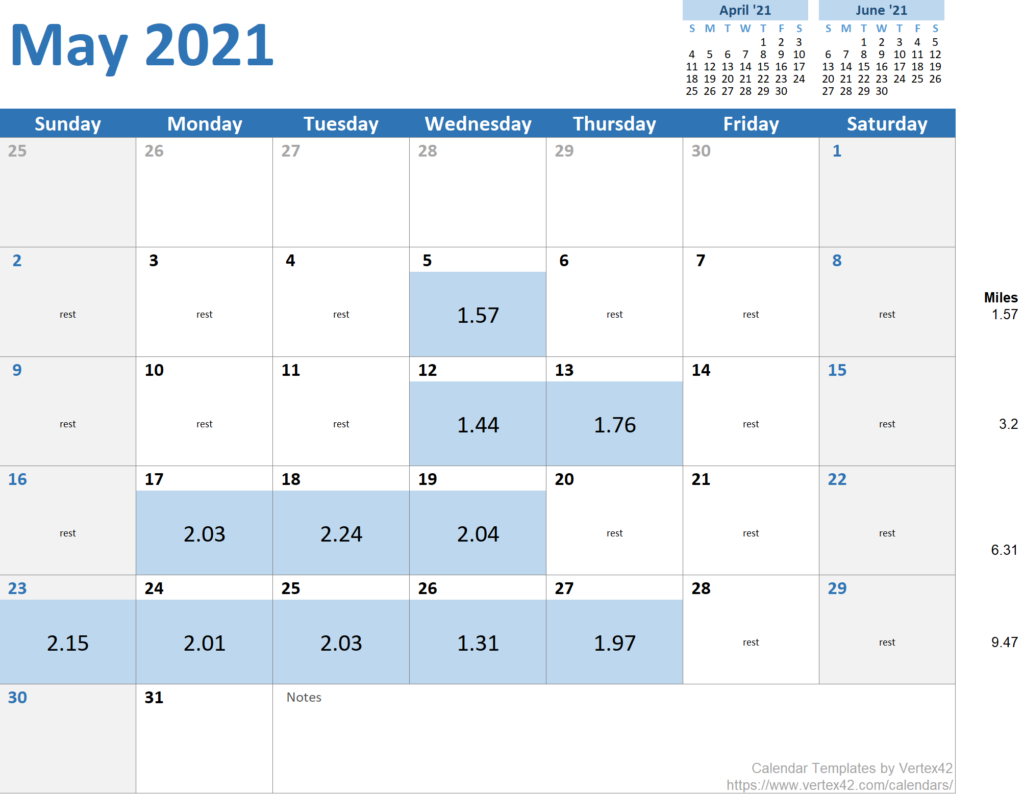Running is associated with high rates of injury, with injury causation often complex and multifactorial [1]. Unfortunately, I found this out the hard way this summer by running into shin splints, a groin strain, and a hamstring strain all within two weeks. Months of progress and running halted from my body breaking down. And more than anything, it was extremely frustrating that I couldn’t run anymore on these 90-degree beautiful days and equally frustrating that this could happen to me when I thought I’d been so methodical. Well, after reviewing my running logs, training routine, and all the scientific evidence surrounding running injury prevention, it appears that I was due for these injuries eventually. What did I do wrong? Although most people think stretching and appropriate footwear are the key to injury prevention [2], do they even matter? And how can we reduce the risk of running injuries based on the scientific evidence? Well, let’s get into it!
Slow Progressive Training Ramp
One of the main things I got wrong despite thinking I was doing it correctly, is slowly progressing my training ramp. From an injury perspective, strenuous running, whether it be an increase in intensity, duration, or frequency are all vital aspects of injury prevalence [3]. If you pull any one of these levers too far or too quickly, your risk for injury increases. Its why first-time marathoners are much more likely to get injured during a race than experienced marathoners [4]. They’re increasing their distance and intensity to a higher level than their previous running sessions, and if not progressed slowly and effectively, that increase can lead to injury. This slow progressive training ramp is what I found in my research to be the most crucial factor for injury prevention.
Like I mentioned, I thought I was slowly progressing my training ramp as recommended but when examining all the levers, I didn’t get this 100% correct. Below, is my running log for the three months prior to my injuries. From a frequency standpoint, I’d run about twice per week in April, three times per week in May, and five times per week in June. I don’t think this was my issue. From a duration standpoint, many recommend not increasing your weekly mileage by more than 10-15% [5]. On average, I was increasing my mileage by about 15% per week which also doesn’t appear to be an issue. But what I didn’t consider when training was my run intensity. In a previous post called My 4 Training Runs for Optimal Health, I detailed my four runs that I cycled through. While I still do all these runs and believe they can all be utilized for optimal health, cycling all four runs equally turned out to be a problem. This is because three out of those four runs I’d do with Olympic level intensity. I was running as if Usain Bolt was chasing me 75% of the time and that’s the problem. Usain Bolt was never chasing me. He had much more important things to do than train with me unfortunately. But after further research, I found out that around 80% of my runs should be easy and 20% of my runs should be difficult [6]. While this may not be the exact proportion based on your goals, it is a useful guideline. And it was basically the opposite of what I was doing. So, while I thought I was ramping up my running slowly, I was putting a lot more wear and tear on my body than I thought. And getting this aspect of running right is critical to staying healthy. Unsurprisingly, when asking 720 recreational runners about injury prevention strategies, the slow progressive training ramp was never mentioned [2].
Injury History
Another primary factor to preventing injury is preventing recurring injuries. Study after study shows that previously injured athletes have a significantly higher injury rate than uninjured athletes. In one study examining hamstring injuries, they examined runner’s lower limb muscle strength, muscle thickness, range of motion, and injury history. Out of all the measurements, only occurrence of previous injury had a significant relationship with future injury risk [7]. This is because most people don’t see a physical therapist or go through a structured rehab process to get injured tissues back to the level of health prior to injury. This makes it much easier to reinjure tissues because they’re unbalanced or weak. And while I’ve never had shin splints before, my hamstring and groin strains are frequent in my injury history. I’ve also never seen a physical therapist or went through a structured rehab program for them, so it makes sense why I keep reinjuring them.
Since this happened over the summer, I’ve seen a physical therapist to provide guidance on the injuries. I then did my own research online to determine what exercises and stretches I should be performing to prevent these from happening in the future. Specifically, I’ve been a huge fan of the content created by E3 Rehab for their evidence-based injury rehabilitation approaches. And I’ve made sure to incorporate those injury specific exercises into my regular resistance training program. And while I won’t mention too much on this, a regular resistance training program is also important in injury prevention. Whether you’re using bodyweight, dumbbells, barbells, or whatever modality, regular progressive strength training is important. And on top of that regular strength training program, be sure to incorporate those extra exercises based on your injury history. For example, lately I’ve been incorporating Copenhagen planks into my leg day for groin strength. I couldn’t even do these when I started and now, I’m planking for nearly 30 seconds. I’ve also added Nordic curls for my hamstrings and other exercises focusing on my previous injury history.
“Appropriate” Shoes
Now let’s touch on some of the topics most people believe prevent injuries. First, appropriate footwear. We’ve all seen advertisements and marketing pushes for all different types of footwear over the years claiming to reduce the risk of injury. From barefoot shoes to maximalist shoes, to shoe cost and foot drop, we’ve seen it all. But does any of it matter? Well, a large study published in 2020 went through all the scientific research and this is what they found. When it comes to several types of shoes like stability, cushioned, or motion-controlled shoes, no evidence on injury prevention. What about age of shoe? No evidence was found between how old a shoe was and injury risk. Does the shoe brand matter? No evidence. Does the cost of the shoe matter? No evidence. What about minimalist shoes? No evidence. Heel drop, the distance from the ground between the front and back of the shoe? Newer runners may benefit from no heel drop while experienced runners may yield better results with a larger heel drop but the evidence isn’t overwhelming. [8]
The study concluded by saying, “It is possible that the role of running shoe technology in injury prevention has been largely overrated. Some basic rules are still valid, such as the subjective feeling of comfort when choosing a pair of running shoes, transitioning progressively and carefully into a new pair, and listening to your body when training. Along the same line, it is probably a good idea to alternate between pairs of running shoes to avoid systematic mechanical overload and allow progressive transitioning to new shoes.” To summarize, despite most people thinking appropriate running shoes prevent injury, the evidence is lacking. It’s possible that certain shoes may be useful for specific situations or populations, but in general, from an injury perspective, just get a couple pair of shoes that you find comfortable and alternate between them.
Stretching / Warm-up
But what about the topic most people believe prevent injuries, stretching? It is a commonly held belief that static stretching plays an important role in improving running performance and decreasing injury risk. But current research evidence definitively reports that this belief is, in fact, incorrect. While stretching may be recommended for certain people in certain situations with certain goals, the static state stretching where you hold a muscle at length for 30 seconds doesn’t appear to decrease injury risk [9]. That doesn’t mean don’t ever stretch, it just means don’t think pre-run stretching will reduce your risk of injury. Instead, a better pre-run approach would be a 5–10-minute dynamic warm-up consisting of leg swings, lunges, high knees, butt kickers, side shuffles, etc. Needless to say, I don’t do any static state stretching before runs. And regarding self-massage like foam rolling [10] or kinesiology tape [11], I also couldn’t find any evidence for injury prevention and don’t utilize either modality.

Sleep, Nutrition, Cognition
The final thing I’ll touch on are key areas that many never consider. Sleep, nutrition, and cognition. In a study looking at the sleep duration of adolescents and athletic injuries, the kids receiving the recommended sleep duration of 9 hours had a significantly lower risk of injury. That study concluded by saying that sleep deprivation is associated with athletic injuries and optimal amounts of sleep may protect against injury [12]. What about nutrition? Another study concluded that, there are several nutrition solutions that can be implemented to reduce the risk of injury and decrease recovery time. These nutritional solutions included getting the optimal amount of protein, Vitamin C, Vitamin D, copper, and calcium [13]. But in general, just eating a nutrient dense diet that meets your micro and macro nutrient requirements is best. And they echoed what I always say, “It should be emphasized that, where possible, all of these nutritional solutions should be explored in a “food first” manner, rather than a reliance on supplements.” So, eat your whole foods! And finally, let’s touch on the cognitive aspect. Research also indicates that running during a rough time in your life can make you more susceptible to stress and injury. Studies show that negative psychological states, low levels of life satisfaction and high levels of stress are linked to athletic injuries [14]. So, make sure you’re managing your stress too! All this to say, everything I talk about here at myHealthSciences is so interconnected. Whether I’m talking about sleep, nutrition, fitness, cognition, finance, or minimalism, they can all be tools to improve your running and reduce your risk of injury.

Final Thoughts
Most people think adequate stretching and footwear are the keys to injury prevention. But from my research, they were far from the most important factors. First, make sure you’re following a slow, progressive running program that accounts for running frequency, intensity, and duration. Second, be sure to follow a consistent strength training program that focuses on preventing injuries from your past. And instead of worrying about all the minute things like kinesiology tape, or foam rolling, or the next hot recovery trend, just stick to the basics. Optimize your sleep. Dial in your nutrition. And manage your stress levels. This is my new plan to not only prevent running injuries, but also to live healthier and happier.
Want a weekly update on the 3 most important things I’ve read, watched, and listened to within the past week?
Watch a YouTube Video Summarizing the Post

Hey, I am Brandon Zerbe
Welcome to myHealthSciences! My goal has always been to increase quality-of-life with healthy habits that are sustainable, efficient, and effective. I do this by covering topics like Fitness, Nutrition, Sleep, Cognition, Finance and Minimalism. You can read more about me here.
Sources:
- [1] Infographic. Running Myth: Switching to a Non-rearfoot Strike Reduces Injury Risk and Improves Running Economy
- [2] Why Are You Running and Does It Hurt? Pain, Motivations and Beliefs about Injury Prevention among Participants of a Large-Scale Public Running Event
- [3] Running-Related Injury from an Engineering, Medical and Sport Science Perspective
- [4] A Randomized Study of a Strength Training Program to Prevent Injuries in Runners of the New York City Marathon
- [5] Marathon Training | Increasing Mileage Safely
- [6] What is 80/20 Training?
- [7] The Risk Factors of Hamstring Strain Injury Induced by High-Speed Running
- [8] Can the “Appropriate” Footwear Prevent Injury in Leisure-Time Running? Evidence Versus Beliefs
- [9] Infographic Running Myth: Static Stretching Reduces Injury Risk in Runners
- [10] Foam Rolling: How Does it Work?
- [11] Is Kinesiology Tape (KT) a Placebo?
- [12] Chronic Lack of Sleep is Associated with Increased Sports Injuries in Adolescent Athletes
- [13] Nutrition for the Prevention and Treatment of Injuries in Track and Field Athletes
- [14] Running Through Stress



